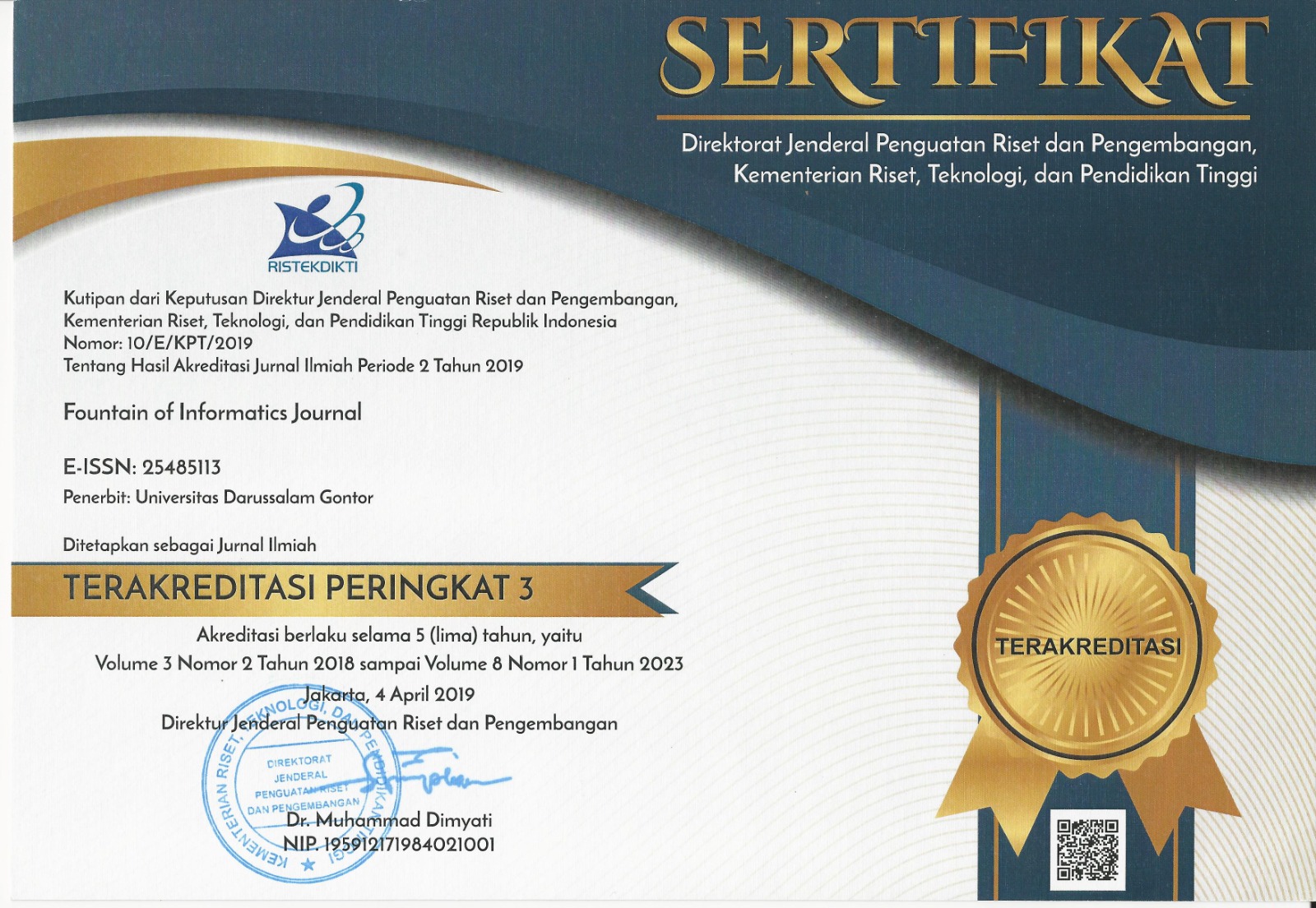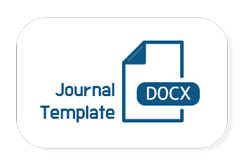Rancang Bangun Learning Management System (LMS) Berbasis Web Di Sekolah Menengah Kejuruan (SMK) Tunas Harapan Kabupaten Pati
DOI:
https://doi.org/10.21111/fij.v6i1.4635Keywords:
Learning Management System (LMS), WebsiteAbstract
AbstrakSaat ini dunia pendidikan telah memanfaatkan kemajuan teknologi informasi dan komunikasi digital. Mulai dari pendaftaran online berbasis website maupun pembelajaran menggunakan e-learning. Namun pembelajaran e-learning belum semua sekolah menerapkan metode pembelajaran dengan metode tersebut. Salah satu sekolah yang belum menggunakan metode e-learning adalah SMK Tunas Harapan Pati. Dari pemaparan tersebut peneliti memberikan sebuah terobosan rancang bangun Learning Managemen System (LMS) untuk mengembangkan pembelajaran e-learning berbasis website. Tujuan dari penelitian ini adalah aplikasi ini bisa digunakan di SMK Tunas Harapan Pati sebagai media pembelajaran e-learning & dilengkapi dengan fitur quiz online secara real time. Rancang bangun LMS menggunakan perancangan terstruktur Data Flow Diagram (DFD). Salah satu aspek dalam e-learning meliputi pemateri, user penerima materi, dan evaluasi. Dengan adanya e-learning lebih memberikan efisiensi waktu dalam dunia pendidikan. Dalam pembangunan sistem ini menggunakan bahasa pemrograman PHP dan database MySQL. Pengujian dilakukan menggunakan pengujian Black Box dengan hasil pengujian pengujian 100% aplikasi layak digunakan. Sedangkan pengujian User Acceptance Test (UAT) yang dilakukan pada lima responden penguji dengan hasil pengujian 88% yang artinya aplikasi layak digunakan oleh pengguna. Dari penelitian ini dapat disimpulkan bahwa aplikasi LMS ini layak digunakan dan kedepannya perlu adanya pengembangan aplikasi LMS berbasis mobile android.Kata kunci: Learning Managemen System (LMS), Website, Sekolah Menengah Kejuruan Abstract[Design of Web-Based Learning Management System (LMS) in Vocational High School of Tunas Harapan, Pati Regency] Currently, the world of education has taken advantage of advances in digital information and communication technology. Starting from online registration based on website and learning using e-learning. However, not all schools have adopted e-learning methods using this method. One school that has not used the e-learning method is SMK Tunas Harapan Pati. From this explanation, the researcher provided a breakthrough in the design of the Learning Management System (LMS) to develop website-based e-learning learning. The purpose of this research is that this application can be used at SMK Tunas Harapan Pati as an e-learning medium and is equipped with an online quiz feature in real-time. LMS design using structured design of Data Flow Diagrams (DFD). One aspect of e-learning includes presenters, users receiving material, and evaluation. The existence of e-learning provides more time efficiency in the world of education. In the development of this system using the PHP programming language and MySQL database. The test is carried out using the Black Box test with the test results of 100% testing the application is fit for use. Meanwhile, the User Acceptance Test (UAT) was conducted on five test respondents with a test result of 88%, which means that the application is suitable for use by users. From this research it can be concluded that this LMS application is suitable for use and in the future there is a need for the development of an Android-based mobile LMS application.Keywords: Learning Management System (LMS), Website, Vocational High SchoolReferences
[1] R. D. Mahande, M. Yahya, and A. M. Mappalotteng, “Pengembangan Portal E-Learning Berbasis Learning Pengembangan Portal E-Learning Berbasis Learning Management System Di Sekolah Menengah Kejuruan,†Indones. J. Educ. Stud., vol. 19, no. 2, pp. 114–120, 2016.[2] M. D. J. Soares, J. E. Borroring, and F. Fitriastuti, “Rancang Bangun E-Learning Universitas Janabadra Menggunakan Efront,†J. Inf. Interaktif, vol. 1, no. 1, pp. 45–54, 2016.[3] F. Komendangi, R. Molenaar, and L. Lengkey, “Analisis Dan Perancangan Aplikasi E-Learning Berbasis Learning Management System (LMS) Moodle Di Program Studi Teknik Pertanian Universitas Sam Ratulangi,†Cocos, vol. 1, no. 3, pp. 13–24, 2017.[4] T. F. Shadek and R. Swastika, “Pengembangan Aplikasi Sistem E-Learning Pada Seluruh Mata Kuliah Dengan Menggunakan Program Hypertext Prepocessor ( PHP ) Dalam Rangka Peningkatan Mutu Proses Dan Hasil Pembelajaran,†J. ProTekInfo, vol. 4, no. 4, pp. 1–18, 2017.[5] Y. Wahyuningsih and S. C. Wibawa, “Pengembangan Aplikasi Test Online dengan Menggunakan Framework CodeIgniter di SMK Darul Ma’wa Plumpang pada Mata Pelajaran Jaringan Dasar Kelas X,†J. IT-Edu, vol. 2, no. 2, pp. 36–46, 2017.[6] T. Muhammad, “Perancangan Learning Management System Menggunakan Konsep Computer Supported Collaborative Learning,†J. Produktif, vol. 1, no. 1, pp. 35–63, 2017.[7] H. Hidayat, Hartono, and Sukiman, “Pengembangan Learning Management System (LMS) untuk Bahasa Pemrograman PHP,†J. Ilm. Core IT Community Res. Inf. Technol., vol. 5, no. 1, pp. 20–29, 2017.[8] Sukenda, Falahah, and F. Lathanio, “Pengembangan Aplikasi Multimedia Pengenalan Pemanasan Global Dan Solusinya Menggunakan Pendekatan ADDIE,†in Seminar Nasional Sistem Informasi Indonesia (SESINDO), 2013, pp. 185–190.[9] R. Afyenni, “Perancangan Data Flow Diagram untuk Sistem Informasi Sekolah (Studi Kasus Pada SMA Pembangunan Laboratorium UNP),†Teknoif, vol. 2, no. 1, pp. 35–39, 2014.[10] D. Puspitasari, C. Rahmad, and M. Astiningrum, “Normalisasi Tabel Pada Basisdata Relasional,†in Prosiding SENTIA, 2016, vol. 8, no. 1, pp. 340–345.[11] A. Firman, H. F. Wowor, and X. Najoan, “Sistem Informasi Perpustakaan Online Berbasis Web,†E-Journal Tek. Elektro Dan Komput., vol. 5, no. 2, pp. 29–36, 2016.[12] M. S. Mustaqbal, R. F. Firdaus, and H. Rahmadi, “Pengujian Aplikasi Menggunakan Black Box Testing Boundary Value Analysis (Studi Kasus : Aplikasi Prediksi Kelulusan SNMPTN),†J. Ilm. Teknol. Inf. Terap., vol. I, no. 3, pp. 31–36, 2015.
Downloads
Submitted
Accepted
Published
Issue
Section
License
Please find the rights and licenses in the Fountain of Informatics Journal (FIJ). By submitting the article/manuscript of the article, the author(s) agree with this policy. No specific document sign-off is required.
1. License
The non-commercial use of the article will be governed by the Creative Commons Attribution license as currently displayed on Creative Commons Attribution-NonCommercial-ShareAlike 4.0 International License.Â
2. Author(s)' Warranties
The author warrants that the article is original, written by the stated author(s), has not been published before, contains no unlawful statements, does not infringe the rights of others, is subject to copyright that is vested exclusively in the author, and free of any third party rights, and that any necessary written permissions to quote from other sources have been obtained by the author(s).
3. User/Public Rights
FIJ's spirit is to disseminate articles published are as free as possible. Under the Creative Commons license, FIJ permits users to copy, distribute, display, and perform the work for non-commercial purposes only. Users will also need to attribute authors and FIJ on distributing works in the journal and other media of publications. Unless otherwise stated, the authors are public entities as soon as their articles got published.Â
4. Rights of Authors
Authors retain all their rights to the published works, such as (but not limited to) the following rights;
- Copyright and other proprietary rights relating to the article, such as patent rights,
- The right to use the substance of the article in own future works, including lectures and books,
- The right to reproduce the article for own purposes,
- The right to self-archive the article (please read out deposit policy),
- The right to enter into separate, additional contractual arrangements for the non-exclusive distribution of the article's published version (e.g., post it to an institutional repository or publish it in a book), with an acknowledgment of its initial publication in this journal (Jurnal Optimasi Sistem Industri).
5. Co-Authorship
If the article was jointly prepared by more than one author, any authors submitting the manuscript warrants that he/she has been authorized by all co-authors to be agreed on this copyright and license notice (agreement) on their behalf, and agrees to inform his/her co-authors of the terms of this policy. FIJ will not be held liable for anything that may arise due to the author(s) internal dispute. FIJ will only communicate with the corresponding author.
6. Royalties
Being an open accessed journal and disseminating articles for free under the Creative Commons license term mentioned, author(s) aware that FIJ entitles the author(s) to no royalties or other fees.Â
7. Miscellaneous
FIJ will publish the article (or have it published) in the journal if the article’s editorial process is successfully completed. FIJ's editors may modify the article to a style of punctuation, spelling, capitalization, referencing, and usage that deems appropriate. The author acknowledges that the article may be published so that it will be publicly accessible and such access will be free of charge for the readers as mentioned in point 3.










